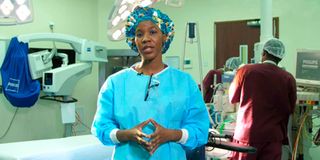Why breast cancer remains a death sentence in Africa

Dr Miriam Mutebi, a breast surgical oncologist at Aga Khan University Hospital.
What you need to know:
- In many parts of Africa, you find that not only are our patients diagnosed with advanced disease, they often do not complete their care.
In 2022 alone, about 1,800 women died from breast cancer worldwide every day. This is according to latest data shared by the World Health Organization. In February, a new study published in the scientific journal Nature Medicine looked at global patterns and trends of breast cancer globally. Healthy Nation spoke to Dr Miriam Mutebi, an oncologist at Aga Khan University Hospital who was one of the study authors.
Why is this study important for Africa?
Breast cancer is the most commonly diagnosed type of cancer. What has been unique to sub-Saharan Africa is that the number of patients with breast cancer is not as high, but we have the highest number of deaths.
We were trying to look where we are in terms of the projections, but also more from a planning perspective - how do we plan to address the rising burden of cancers?

Breast cancer cells sometimes escape detection by the immune system.
In the last 10 years, a number of countries have established national cancer control programmes, meaning they acknowledge that cancer is a problem and are figuring out how to deal with it.
From the planning perspective, we have also seen new investments in terms of cancer care and provision.
You mentioned that countries in Africa like Kenya have the highest number of deaths despite having fewer cases. What could be the reason for this high mortality rates in our countries compared to the high income countries?
In many parts of Africa, you find that not only are our patients diagnosed with advanced disease, they often do not complete their care. And if we do a deeper dive into that, we almost see a constellation of factors.
Patients have to pay out of pocket in order for them to access care, which usually results in catastrophic health expenditure.
In the West, the expenditure of women with a cancer diagnosis is about 30 per cent of their total annual household income.
In low and middle income countries, women’s expenditure for cancer care is almost 160 per cent of their annual household income.
The other hurdle is in our health systems. Despite advances in education and training, we still see that many patients see an average of four to six health care providers before getting a diagnosis of cancer.
Also, generally, patients in Africa tend to be 10 to 15 years younger than their counterparts in the West. Younger patients are sometimes dismissed and that causes delays in diagnosis. Sometimes, the idea is not even just the recognition, but also prompt referral. We are trying to strengthen the capacity of providers to actually support diagnostics because we have had improvements in terms of treatment but the diagnostic part has been lagging behind.
We also still have some countries that do not have key equipment for cancer.
Do we have socio-cultural barriers as well?
Yes we do, and people rarely talk about it. There is still a lot of stigma around breast cancers, and it’s quite pervasive in Africa. We have had patients who have been told that after they’ve had a mastectomy they shouldn’t go home. That they’re half the women they used to be.
There are lots of partners who are supportive, but there are also many who aren't. Telling a woman in Africa that they have cancer is not just about having cancer, they could lose their family or their source of livelihood. It is a very loaded sort of diagnosis.
In many parts of Africa, women are not necessarily the primary determinants of their health seeking behavior. Our community is our strength in Africa. But then, when the community starts to infringe on the patient’s ability to make their own decisions about their treatment, it inhibits their cancer care. I have had patients who needed to have medical therapies and the family would insist that they should do juicing.
Why do we see this trend of younger patients?
Well, the simple reason is that nobody knows. People are thinking it could be part of our population structure, where the average age is about 18. Our average age of diagnosis of patients in the last 10 years may be between 40 to 55. But at least 30 per cent of patients are under 40.
This is a combination of different things, it could be that there is more reporting of the disease. The other argument is that we are now living longer, our life expectancy has gone up to 65. We're now living long enough to acquire some lifestyle diseases.
Unlike in the west where younger patients may know their cancer diagnosis because of their family history, it is quite the opposite here. Some younger people are the first in their families and that is what we are studying to find out the reason. One of the studies we are doing at Aga Khan is to look at the genetic composition of cancer. Usually, for you to get cancer, you sometimes have some genes that are either increased or decreased. If you look at the gene profile for African patients versus African-American versus patients who have a Caucasian ancestry, it's totally different. Africans also have a more aggressive type of cancer.
Our younger age also makes us have the highest proportion of cancer cases and deaths under 50 in Africa. This is when women are at their most productive.
We also have the highest number of what we call maternal orphans. It's roughly about 200 children estimated to become maternal orphans for every 100 cancer deaths for women under 50 in Africa.
The study shows that mammography offers better results compared to clinical breast examination. Why is this the case?
The gold standard for screening worldwide is mammography.
It is a special type of X-ray that you use to examine the breast. The rationale or the advantage behind the mammogram is it's able to pick up lumps even before you start to feel them. Sometimes, even one to two years before you start to feel a lump.
Even in the best of hands, a clinical exam can only pick up a lump when it's a certain size. Whereas with the mammogram, you're able to see some of these early changes. And now even with enhancements such as artificial intelligence, they're now saying they can predict changes even up to five years ahead of time. Our national screening guidelines actually try to merge clinical breast exam and mammography screening if available.
We have mammography machines in 47 counties in Kenya, are they effective?
The World Health Organization proposed early detection in low and middle income countries. However, a national widespread mammography programme is expensive to maintain. Now that we have the machines in counties, the reason that hasn’t really translated is because we don’t have enough radiologists in the country. The biggest investment in health is the workforce. Also, the younger patients we have would not fit the criteria up front for mammography screening. It is mostly done to people over 40 years old. So, it begs the question, is this really the optimal screening tool in our setting?
Does this mean that women or men under under 40 cannot have a mammography?
It doesn't mean they cannot. It just means the diagnostic accuracy of mammograms in women under 40 is not great. The breast is generally made up of glands, which are the ones that produce milk and then the ducts that then transport the milk to the nipple area. So basically, just because from an evolutionary perspective, the main function of the breast is to provide nutrition for babies. Now, as you grow older, these glands tend to shrink and disappear and get replaced with fatty tissue.
That's why you find with older women, their breasts probably feel a little softer and they start to drop because the glands are decreasing and the fat is increasing. Now, with the mammogram, as an x-ray, you're trying to shine a light through some tissue.
So in younger women, just because they have so many glands, the glands just scatter the light. So all you see is white. You can't really interpret the mammogram correctly.
You need to do an ultrasound and stuff. It's not ideal. It's not an ideal tool for screening in women whose breasts are at a younger age.
What are the general risk factors for cancer?
The first is being female and growing older, that we can’t change. Some of the traditional ‘protective factors’ like early pregnancy, breastfeeding before 30 and having multiple children are now being challenged. I got into breast oncology because most of my patients had profiles that conform to the protective factors. Alcohol intake, using some oral family planning frequently, smoking and physical inactivity can predispose you to getting the disease.


